Part 7. Why study deflation, debased money, barter, confidence, and fraud?
This is Part Seven of a Ten part series showing how inflation, deflation, barter, tariffs, taxes, postage, war, counterfeiting, history, economics, free trade, famine, dearth, climate, auctions, precious metals, religion, and education are combined into one great whole.
Part 7. Why study deflation, debased money,
barter, confidence, and fraud?
14) Deflation by debasing its coins. The U.S. abandoned gold backed currency in 1934, even passing a law making holding gold illegal except for dental work, jewelry, or medicine. Then the U.S. abandoned silver backed currency and removed silver in 1964 from legal tender coins, the dime and quarter, and half (by 1966) all went to clad, a term for nickel and zinc copper sandwich.  On April 2, 1792, Congress passed the Coinage Act, also known as the Mint Act, created the United States Mint, “at the seat of the government of the United States.” The U.S. Mint building in Philadelphia was the first Federal building created under the Constitution.
On April 2, 1792, Congress passed the Coinage Act, also known as the Mint Act, created the United States Mint, “at the seat of the government of the United States.” The U.S. Mint building in Philadelphia was the first Federal building created under the Constitution.
You can see this on the edge of the post 1965 coins. Few Americans noticed or cared. The copper cent, as big as a half dollar, was minted from about 1787 to 1856, when it was shrunk to the size of a dime. The old cents became the ‘large’ cents, and the new ones, the ‘small’ ones the small cents. The ‘small’ copper (95%) cents continued for over a century until 1982, when the price of copper could not sustain minting billions a year. So the mint changed the cent from copper to Zinc (95%). Zinc is one periodic chart element above copper, meaning Zinc weighs more than copper for the same volume, a term called specific gravity. So the new cents, because they were the same diameter as copper, but weighing more, the mint reduced the thickness of the zinc cents by 2 percent, to keep the weight the same. Diameter and weight were the same, just the thickness of the cent was tweeked. Again few noticed. In 2013, the US Mint spent 2 cents to make a one zinc Lincoln cent. The pre 1983 copper cents replacement costs are 4 cents each.
Scotland King James 3rd (1460-1488) debased his coinage between 1480 and 1482, reducing the silver content from about 0.925 fineness to 0.770 fineness of silver.[i] James’ mint produced copper coins known as black money, which lead to monetary inflation, but was so unpopular, the small coppers were not minted again for over a century. Scotland also suffered from clipping, where the edge of the silver coin was shaved, collected and melted into more coins, and the old shaved or clipped coin was put back into circulation at full face value.[ii] 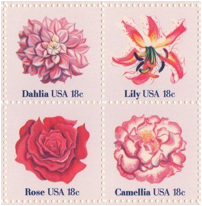 Postage was eighteen cents (18 cents) two months into the Reagan Presidency, These Flowers Rose Camellia Dahlia and Lily were 1981 Eighteen cent stamps.
Postage was eighteen cents (18 cents) two months into the Reagan Presidency, These Flowers Rose Camellia Dahlia and Lily were 1981 Eighteen cent stamps.
War time brings out debasement, and barter. About a century into the Protestant Reformation, on 1621, the many Dukedoms of the Holy Roman Empire began to debase their coins to finance what would be called the Thirty Years War. As the Holy Roman Empire was Germanic, this was called Kipper und Wipper (German: Kipper- und Wipperzeit, literally “Tipper and See-saw time”. [iii] Tipping scales were used to weigh and measure money. So money would be put on the balance, and if the scale tipped toward the coins, meaning it was gold or silver, the coin would be withdrawn from the circulation, melted down, and mixed with the base metals, such as lead for gold, or copper and tin with silver, and re minted. Often the states would counterfeit coins from other countries and spend the debased money as far away as possible, to limit damage to the local economy. Eventually, the bad money, having driven out the good, would not be accepted by the general public, and refusal to accept any coins, real or counterfeit.
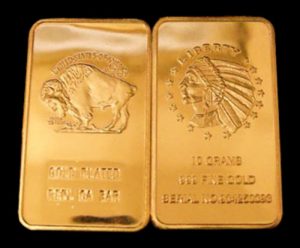 Counterfeit bar [obverse] ‘’United States of America Gold Plated Real GA Bar [reverse] Liberty 10 Grams .999 Fine Gold Serial No. 220093.’’ Back story. As of 2018 May 24, authentic 10 gram .999 Fine gold is bid at $442, [Gold price market at $1,307.50 per ounce]. These bars are sold on line at $2 to $5 each, and worth 50 cents in metal. The ‘gold plated’ attempts to avoid counterfeit charges that the obverse language ‘10 grams .999 fine gold’ is a total lie. What if you don’t read English? Isn’t the ‘United States of America’ the trade mark for the government? The same applies to ‘copy’ coins. Obliterating ‘plated’ is not difficult.
Counterfeit bar [obverse] ‘’United States of America Gold Plated Real GA Bar [reverse] Liberty 10 Grams .999 Fine Gold Serial No. 220093.’’ Back story. As of 2018 May 24, authentic 10 gram .999 Fine gold is bid at $442, [Gold price market at $1,307.50 per ounce]. These bars are sold on line at $2 to $5 each, and worth 50 cents in metal. The ‘gold plated’ attempts to avoid counterfeit charges that the obverse language ‘10 grams .999 fine gold’ is a total lie. What if you don’t read English? Isn’t the ‘United States of America’ the trade mark for the government? The same applies to ‘copy’ coins. Obliterating ‘plated’ is not difficult.
The drawing is a German mint producing debased counterfeit coinage for shipment to a neighbor and competing state. 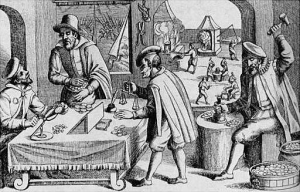 On the table are ledgers to guide the seated money changer. The man in the cape holds in his right hand a balance scale to weigh coins or metal against known values. The seated man is holding a mallet in his left hand, by which to pound a planchet of metal on a hard metal steel or iron die, the size of a coin, to make the impression of the coin. More mallet pounders are in the background in the court yard, indicating the location was a central mint. A man in the yard appears to be standing in front of a oven with fire coming out, opening or closing a bellows to blow the fire and melt the gold, silver, copper, tin, zinc, or lead. In front at the base of the drawing are barrels of coins or planchets. A planchet is a round metal disk ready to be struck into a coin. Smithsonianmag.com[iv]
On the table are ledgers to guide the seated money changer. The man in the cape holds in his right hand a balance scale to weigh coins or metal against known values. The seated man is holding a mallet in his left hand, by which to pound a planchet of metal on a hard metal steel or iron die, the size of a coin, to make the impression of the coin. More mallet pounders are in the background in the court yard, indicating the location was a central mint. A man in the yard appears to be standing in front of a oven with fire coming out, opening or closing a bellows to blow the fire and melt the gold, silver, copper, tin, zinc, or lead. In front at the base of the drawing are barrels of coins or planchets. A planchet is a round metal disk ready to be struck into a coin. Smithsonianmag.com[iv]
The coins or money lost their purchasing power, and hence its ability to preserve value. Pamphlets denounced the practice of debasement and counterfeit, riots occurred, the soldiers and mercenaries refused to fight unless paid in real, non-debased money, called specie. Within a few years, by 1623, the states got back their own debased coins in taxes and custom fees, so the debasement and counterfeit ended. The financial disarray lead to barter economies, so the damage was done. Mints were established to debase metal coins, so much so, children played with the ‘tokens’ in the street, as in the short story by Leo Tolstoy “Ivan the Fool“.
15) Deflation by losing money. US limits on international currency transfers, or so the claim goes, that people are to report cash of $10,000 taken in or out of the country.[v]
16) Deflation by loss of confidence in money. Not enough money, and too many goods or services is deflation. Bad money drives out good. I.e. The silver coins disappeared when replaced by clad money. Washington silver quarters (1932-1964), Roosevelt silver dimes (1946-1964), and Kennedy silver halves (1959-1970) were pulled from circulation by banks and collectors, when the clad money arrived (i.e. Zi and Cu and Ni). By 1971 circulation strikes (so called because they were meant for banking and commerce, or circulation, and not for collectors) were all copper and nickel alloys, and contain no silver. 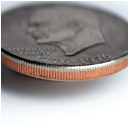 Collector strikes included commemorative coins, such as the Kennedy 2014 Gold half dollar, sold to collectors. 1776-1976 clad Eisenhower Dollar. The yellow line is copper. Planning the post world war economy, the countries met at Bretton Woods in 1944 and set various rates of exchange between countries. This lasted about a quarter of a century, when the US abandoned the Gold exchange under President Nixon, circa 1971.
Collector strikes included commemorative coins, such as the Kennedy 2014 Gold half dollar, sold to collectors. 1776-1976 clad Eisenhower Dollar. The yellow line is copper. Planning the post world war economy, the countries met at Bretton Woods in 1944 and set various rates of exchange between countries. This lasted about a quarter of a century, when the US abandoned the Gold exchange under President Nixon, circa 1971.
Magna Charta of 1215, lists the England’s King John’s titles, was directed to the Archbishops, bishops, abbots, earls, barons, justices, foresters, sheriffs, stewards, servants and subject. ‘’ (41) All merchants may enter or leave England unharmed and without fear, and may stay or travel within it, by land or water, for purposes of trade, free from all illegal exactions, in accordance with ancient and lawful customs. This, however, does not apply in time of war to merchants from a country that is at war with us. ‘’[vi] US Constitution lists honest weights measures. coinage and currency as a power of the federal government.
17) Barter in the Bible. In Genesis 38 we read the tale of Judah, Second of twelve sons of Jacob later renamed Israel, who offers a kid from the flock, to an unknown harlot in a neighboring town, Timnath, who just happened to be Judah’s daughter in law Tamar. Tamar, knowing her father-in-law well, had disguised herself as a harlot. Judah, busy from shearing sheep, wanted very much to come in unto her. Tamar asked what will Judah offer (pay) and Judah offers a kid. As Judah was shearing sheep, the kid was probably a sheep, but the term might mean a goat. 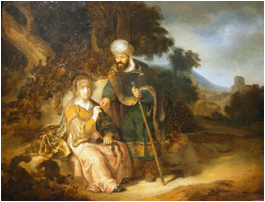 Painting of Tamar and Judah, with Judah’s staff, signet ring in hand, and Tamar holding a bracelet in her left hand. Judah has no kid. In this picture, Tamar’s face is shown. Whereas in the real event, either Tamar covered her face, or Judah’s cataract’s were so thick he could not see.
Painting of Tamar and Judah, with Judah’s staff, signet ring in hand, and Tamar holding a bracelet in her left hand. Judah has no kid. In this picture, Tamar’s face is shown. Whereas in the real event, either Tamar covered her face, or Judah’s cataract’s were so thick he could not see.
The story is silent as to whether Judah had any silver or gold on him to buy the service of a harlot. Perhaps, he did, or perhaps he didn’t. If Judah had no silver or gold, he was not very prepared for the barter. Assume Judah did have silver and gold, but Tamar turns the money down. That would be odd, but imagine Tamar saying ‘I don’t want money’, giving the excuse for which money can be easily stolen, or counterfeited. How can I tell if the silver or gold are pure, and not debased? Tamar doesn’t want money, pure or debased, because it is too common – the very opposite of barter. So Tamar, looks at Judah, to make sure she asks for something Judah doesn’t appear to have with him at that moment. Not seeing a goat, Tamar asks for the kid, but she doesn’t really want a kid, either. Judah is pleased at the bargain. He keeps his money, gets services now, and can send a kid later. Tamar wanted a trail, a provenance, of the service to her customer, father in law, on the guise or pretext of getting her kid. Tamar asks what is the immediate pledge for the kid? Or, translating, Tamar asks what do you have on you right now, because after you have your way, you’ll leave and I’ll receive nothing, and I’ll never see you again. So Judah left Judah’s signet (usually a ring), bracelet, and staff with Tamar. Judah does come into Tamar, and leaves Tamar in the family way. That was Tamar’s design all along. After Judah is out of sight, which probably was not very long indeed, Tamar, gets up, changes her clothes and disappeared from the location, which was one or several towns over from her tent or home. Meanwhile Judah, returning to work, sent his friend, the Adulamite with the kid for payment to redeem Judah’s signet, bracelet and staff, but the friend could not find the harlot in the place. The friend even asked the neighbors, still trying to redeem the signet, bracelet and staff. This sounds like a lot of trouble, but the Adulamite seems not to protest the favor, perhaps hoping for a tip in return. But to no avail. Months later, when Tamar was showing her pregnancy, Tamar was brought forth to her customer, father-in-law, to be burnt for harlotry. Tamar apparently knowing this would happen, made sure to keep the signet, bracelet and staff with her at all times, as there would probably be no chance to recover and return for them. 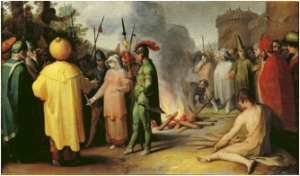 Tamar said publicly so all would observe, here are the tokens of the baby’s father, look familiar, huh, dad? Judah acknowledged fatherhood and the twin babies Pharez and Zarah were born. Tamar presenting the staff, bracelet and signet to the father. Judah acknowledges the child(ren).
Tamar said publicly so all would observe, here are the tokens of the baby’s father, look familiar, huh, dad? Judah acknowledged fatherhood and the twin babies Pharez and Zarah were born. Tamar presenting the staff, bracelet and signet to the father. Judah acknowledges the child(ren).
This barter gets a whole chapter in the First Book of Moses, Genesis, alongside Noah’s flood, and the courtships of Rebecca and Rachel. The story makes chapter 38 in the Bible because Tamar is an ancestress, and Judah an ancestor, after about eight centuries, of David the King, who in turn is prophesied two centuries later by Isaiah to be ancestor of the Messiah, and after about 18 centuries of Jesus Christ, the Messiah. Barter is far less efficient (by 1 in a hundred) than a society with a means of exchange for preserving value.  Postage was twenty cents (20 cents) when the US National Debt was a Trillion, This bridge over the East river between Brooklyn and Manhattan is honored by the 1883-1983 Brooklyn Bridge Centennial 20 cent stamp.
Postage was twenty cents (20 cents) when the US National Debt was a Trillion, This bridge over the East river between Brooklyn and Manhattan is honored by the 1883-1983 Brooklyn Bridge Centennial 20 cent stamp.
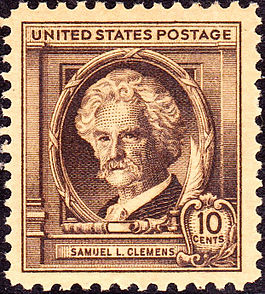 18) Think of Barter as a child’s economy. Trading bubble gum for baseball cards, or marbles for toys, belt buckles for candy. 1940 Samuel L. Clemens 10 Cents.
18) Think of Barter as a child’s economy. Trading bubble gum for baseball cards, or marbles for toys, belt buckles for candy. 1940 Samuel L. Clemens 10 Cents.
A famous child’s barter was written up by Mark Twain in Tom Sawyer (by the way Tom Sawyer is the world’s first novel to be composed on a Typewriter, instead of pen and ink, about 1874 while Mark Twain lived in Connecticut). Tom is tasked with white washing the picket fence, so thinking it through, he sings and dances while brushing on the white wash, attracting his young ten or twelve year old friends. First he offers to fetch water in a bucket if Jim will white wash. Then Tom offers a marvel, a white Alley. Then Tom offers to show his sore toe, all bandaged and wound. 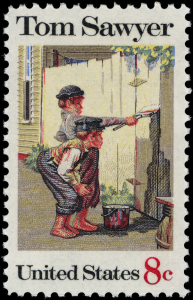 When asked why Tom is happy, Tom replies he enjoys the fun of white washing, and soon the boys want to help. Tom Sawyer, 8 cent United States Postage. 1972. But to seal the deal, Tom asks for a pledge, just look at the boot for Tom – Tom had traded the next chance to Billy Fisher for a kite, in good repair; and when he played out, Johnny Miller bought in for a dead rat and a string to swing it with – and so on, and so on, hour after hour. And when the middle of the afternoon came, from being a poor poverty-stricken boy in the morning, Tom was literally rolling in wealth. He had besides the things before mentioned, twelve marbles, part of a jews-harp, a piece of blue bottle-glass to look through, a spool cannon, a key that wouldn’t unlock anything, a fragment of chalk, a glass stopper of a decanter, a tin soldier, a couple of tadpoles, six fire-crackers, a kitten with only one eye, a brass door-knob, a dog-collar – but no dog – the handle of a knife, four pieces of orange-peel, and a dilapidated old window sash. whatever barter the boys had, for the privilege of the white wash. So barter is a child’s economy.
When asked why Tom is happy, Tom replies he enjoys the fun of white washing, and soon the boys want to help. Tom Sawyer, 8 cent United States Postage. 1972. But to seal the deal, Tom asks for a pledge, just look at the boot for Tom – Tom had traded the next chance to Billy Fisher for a kite, in good repair; and when he played out, Johnny Miller bought in for a dead rat and a string to swing it with – and so on, and so on, hour after hour. And when the middle of the afternoon came, from being a poor poverty-stricken boy in the morning, Tom was literally rolling in wealth. He had besides the things before mentioned, twelve marbles, part of a jews-harp, a piece of blue bottle-glass to look through, a spool cannon, a key that wouldn’t unlock anything, a fragment of chalk, a glass stopper of a decanter, a tin soldier, a couple of tadpoles, six fire-crackers, a kitten with only one eye, a brass door-knob, a dog-collar – but no dog – the handle of a knife, four pieces of orange-peel, and a dilapidated old window sash. whatever barter the boys had, for the privilege of the white wash. So barter is a child’s economy.
Mark Twain philosophized over this event
Tom said to himself that it was not such a hollow world, after all. He had discovered a great law of human action, without knowing it – namely, that in order to make a man or a boy covet a thing, it is only necessary to make the thing difficult to attain. If he had been a great and wise philosopher, like the writer of this book, he would now have comprehended that Work consists of whatever a body is obliged to do, and that Play consists of whatever a body is not obliged to do. And this would help him to understand why constructing artificial flowers or performing on a tread-mill is work, while rolling ten-pins or climbing Mont Blanc is only amusement. There are wealthy gentlemen in England who drive four-horse passenger-coaches twenty or thirty miles on a daily line, in the summer, because the privilege costs them considerable money; but if they were offered wages for the service, that would turn it into work and then they would resign.
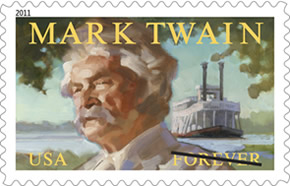 2011 Mark Twain forever stamp, which increases in value as rates rise. Literary arts series. Commemorates the century after his death in 1910. Born Samuel Clemens, Mark Twain took his name from his time working as a riverboat pilot on the Mississippi – as shown in the stamp. Mark Twain for the boatman taking a plumb sounding on the bottom of the river and at least Two fathoms deep- about 12 feet deep, enough to pass without running aground.
2011 Mark Twain forever stamp, which increases in value as rates rise. Literary arts series. Commemorates the century after his death in 1910. Born Samuel Clemens, Mark Twain took his name from his time working as a riverboat pilot on the Mississippi – as shown in the stamp. Mark Twain for the boatman taking a plumb sounding on the bottom of the river and at least Two fathoms deep- about 12 feet deep, enough to pass without running aground.
http://www.pbs.org/marktwain/learnmore/writings_tom.html
19) Think of Barter as a primitive economy. Trading goods, such as pieces of glass or metal to the local Seyseys, chief of the Canarsees (Lenape tribe), for Manhattan Island, New Amsterdam, as was claimed by the Dutch, Peter Minuit in 1626. Such is the barter economy – a child’s economy, a primitive economy. But you can find other examples, such as the British controlling salt in India. Salt was used to preserve food in the tropics, which lacked ice and cold, vinegar, or sugar for curing food. Salt was bartered out for silver or services.
20) Deflation due to taxes which taxes reduce money in circulation. Taxes, tariffs and levies are mentioned in the Bible and Book of Mormon. In Genesis, Joseph, in behalf of Pharaoh, takes a fifth of the food during the 7 years of plenty, but the farmers don’t seem to mind, as they had no place to store it, and the government did them a favor to haul it off. Then in the famine, the government, Pharaoh and Joseph, sold the food back to the people for the cash, stock, then lands, and now as landlord over the land, rented it back to the people. The tradition of kings began, wherein the king owned everything, and could charge rent. A form of income tax.
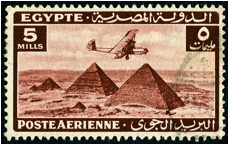 5 mills Egypte Posteaerienne, showing pyramids and airplane. Joseph goes to Egypt.
5 mills Egypte Posteaerienne, showing pyramids and airplane. Joseph goes to Egypt.
Genesis 47 verse 14, 14 And Joseph gathered up all the money that was found in the land of Egypt, and in the land of Canaan, for the corn which they bought: and Joseph brought the money into Pharaoh’s house. 15 And when money failed in the land of Egypt, and in the land of Canaan, all the Egyptians came unto Joseph, and said, Give us bread: for why should we die in thy presence? for the money faileth. 16 And Joseph said, Give your cattle; and I will give you for your cattle, if money fail. 17 And they brought their cattle unto Joseph: and Joseph gave them bread in exchange for horses, and for the flocks, and for the cattle of the herds, and for the asses: and he fed them with bread for all their cattle for that year. 18 When that year was ended, they came unto him the second year, and said unto him, We will not hide it from my lord, how that our money is spent; my lord also hath our herds of cattle; there is not ought left in the sight of my lord, but our bodies, and our lands: 19 Wherefore shall we die before thine eyes, both we and our land? buy us and our land for bread, and we and our land will be servants unto Pharaoh: and give us seed, that we may live, and not die, that the land be not desolate.20 And Joseph bought all the land of Egypt for Pharaoh; for the Egyptians sold every man his field, because the famine prevailed over them: so the land became Pharaoh’s. 24 And it shall come to pass in the increase, that ye shall give the fifth part unto Pharaoh, and four parts shall be your own, for seed of the field, and for your food, and for them of your households, and for food for your little ones. 25 And they said, Thou hast saved our lives: let us find grace in the sight of my lord, and we will be Pharaoh’s servants. 26 And Joseph made it a law over the land of Egypt unto this day, that Pharaoh should have the fifth part; except the land of the priests only, which became not Pharaoh’s (verse 20).
When Egypt’s money failed, no money was left to chase food. It didn’t mean there was no money, for clearly Pharaoh had all the money. And there was plenty of food. So Egypt spiraled down into a deflation economy and eventually, a barter economy (verse 17), until Pharaoh owned everything.
Jesus said ‘you always have the poor with you’. Meaning there are those whose excess services (labor) chase fewer products, a deflation, so the poor are left within the barter economy, unable to accumulate any value to make longer term plans. They are left to a hand to mouth existence. But the loss of product and goods would create a surplus of money, unless the money were confiscated as well. If not, the tax would cause an inflation on the price of the remaining food.
Across the oceans, the people of Alma, escaping from the Lemuelites and Noah’s court, are caught by the Lamanites, and must pay half of their product (food, live stock and grains) to the Lamanites. A form of income tax. The remaining food, if scarceness came to famine, would be price higher.
In Luke chapter 2, verse 1, Caesar Augustus decreed all the world should be taxed. Of So Joseph of Nazareth takes his wife to Bethlehem. The amount and form of tax is not give. Some say the word ‘tax’ in the King James version of the Bible is a ‘census’ to count everyone, but a census was to determine how many soldiers were possible to draft or conscript, which also a form of taxation. Whichever, the decree would either reduce money in circulation, or labor available for hire, and in both the price of labor would change. 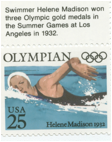 Postage was a quarter (25 cents) for the Moscow summit of 1988 with President Reagan, Swimmer Helene Madison won three Olympic gold medals in the Summer games at Los Angeles in 1932. Two of these stamps would mail a letter in 2018.
Postage was a quarter (25 cents) for the Moscow summit of 1988 with President Reagan, Swimmer Helene Madison won three Olympic gold medals in the Summer games at Los Angeles in 1932. Two of these stamps would mail a letter in 2018.
In the Bible, Abraham purchased a burial plot in Shechem for 20 pieces of silver. Silver is an early medium of exchange. The plot was later used by Jacob and others.
Mosaic law – fair weights and measures. Silver and gold is mentioned.
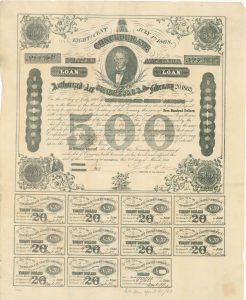 500 Eight per Cent July1st 1868 Confederate 500 States of America 500 No.94633 Loan Graphic Loan. Authorized by the Act of Congress C.S.A. of February 20, 1863. On the 1st day of July 1868 Confederate States of America will pay to the Bearer of this Bond at the seat of Government or at such place of deposit as may be appointed by the Secretary of the Treasury, the sum of Five Hundred Dollars, with interest thereon from date, at the rate of Eight per Cent per annum, Payable semi annually on the surrender of the annexed Coupons. This Contract is authorized by An Act of Congress approved February 20, 1863 Entitled An Act to Authorize the issue of Bonds for funding Treasury notes and is upon the Express condition that said Confederate States may from time to time extend the time of payment for an period not exceeding thirty years from this date, at the same rate of interest upon the surrender of the Bond. In Witness thereof the Register of the Treasury in pursuance of said Act of Congress hath hereunto set his hand and affixed the seal of the Treasury at Richmond, This 2nd day of March 1863 500 Register of the treasury 500 Evans & Cogswell Lith Columbia SC. G.S. Loan Feby 20, 1863 the Confederate States of America will pay to the Bearer Twenty Dollars $20 For Six Months interest Due Jany 1st, July 1st, [1868, 1867, 1866, 1865, 1864, 1863] On Bond No. 47633 for $500 For Register of the Treasury.’’ The bond deflated to zero, and no coupons were redeemed. $500 money in 1860s would buy 100 to 250 steers on the hoof in Texas.
500 Eight per Cent July1st 1868 Confederate 500 States of America 500 No.94633 Loan Graphic Loan. Authorized by the Act of Congress C.S.A. of February 20, 1863. On the 1st day of July 1868 Confederate States of America will pay to the Bearer of this Bond at the seat of Government or at such place of deposit as may be appointed by the Secretary of the Treasury, the sum of Five Hundred Dollars, with interest thereon from date, at the rate of Eight per Cent per annum, Payable semi annually on the surrender of the annexed Coupons. This Contract is authorized by An Act of Congress approved February 20, 1863 Entitled An Act to Authorize the issue of Bonds for funding Treasury notes and is upon the Express condition that said Confederate States may from time to time extend the time of payment for an period not exceeding thirty years from this date, at the same rate of interest upon the surrender of the Bond. In Witness thereof the Register of the Treasury in pursuance of said Act of Congress hath hereunto set his hand and affixed the seal of the Treasury at Richmond, This 2nd day of March 1863 500 Register of the treasury 500 Evans & Cogswell Lith Columbia SC. G.S. Loan Feby 20, 1863 the Confederate States of America will pay to the Bearer Twenty Dollars $20 For Six Months interest Due Jany 1st, July 1st, [1868, 1867, 1866, 1865, 1864, 1863] On Bond No. 47633 for $500 For Register of the Treasury.’’ The bond deflated to zero, and no coupons were redeemed. $500 money in 1860s would buy 100 to 250 steers on the hoof in Texas.
[i] https://glasgowuniscotrenaissance.wordpress.com/2017/01/25/coinage-of-james-iii-r-1460-1488-type-ii-iv-vi/ [Debasing coins, melting gold and silver with alloys of copper, lead, zinc and antimony] led to a monetary inflation which devalued the Scottish coin against its English counterpart and exacerbated socio-economic woes. Worth noting however is that the king was in fact acting in line with the devaluation practices of other European countries like France and Italy at this time. The circulation of small copper coins during [King of Scots] James III’s reign [1460-1488] was useful in providing change in minor transactions and highlights the influence that renaissance ideas and continental practices had on Scotland.[14]James III’s experiment can however be deemed a failure and was widely unpopular, as evidenced by the fact smaller copper coins were not to be struck again until 1597.’’
[ii] https://glasgowuniscotrenaissance.wordpress.com/2017/01/25/coinage-of-james-iii-r-1460-1488-type-ii-iv-vi/ Coin Clipping was a medieval crime that involved the shaving of metal from the coin’s circumference (outside edge) and then over time melting down the clippings to make new coins.[19] This clipped silver coin thus serves to highlight the various means of coin debasement that continued even late into James III’s reign [circa 1488]..
[iii] “The German economic crisis of 1618 to 1623” , Bundesbank quoted by Wikipedia.
[iv] Rogue Princes, Rogue Bishops and the German Financial Meltdown of 1621-23
Read more: https://www.smithsonianmag.com/history/kipper-und-wipper-rogue-traders-rogue-princes-rogue-bishops-and-the-german-financial-meltdown-of-1621-23-167320079/#HHj3u6zqSEO8gcym.99
[v] On Jan. 16, 2016, the same day four American detainees, including The Washington Post’s Jason Rezaian, were released, a jumbo jet carrying $400 million in Euros, Swiss francs and other currencies landed in Tehran. That money purportedly was partial payment of an outstanding claim by Iran for U.S. military equipment that was never delivered. Soon after, $1.3 billion in cash followed. The Wall Street Journal reported that the head of the Justice Department’s national-security division objected that it would look like a ransom payment.
[vi] https://www.bl.uk/magna-carta/articles/magna-carta-english-translation#
Disclaimer: The author of each article published on this web site owns his or her own words. The opinions, beliefs and viewpoints expressed by the various authors and forum participants on this site do not necessarily reflect the opinions, beliefs and viewpoints of Utah Standard News or official policies of the USN and may actually reflect positions that USN actively opposes. John Choate © No claim in public domain or fair use.
Utah Standard News depends on the support of readers like you.
Good Journalism requires time, expertise, passion and money. We know you appreciate the coverage here. Please help us to continue as an alternative news website by becoming a subscriber or making a donation. To learn more about our subscription options or make a donation, click here.
To Advertise on UtahStandardNews.com, please contact us at: ed@utahstandardnews.com.


Comments - No Responses to “Part 7. Why study deflation, debased money, barter, confidence, and fraud?”
Sure is empty down here...